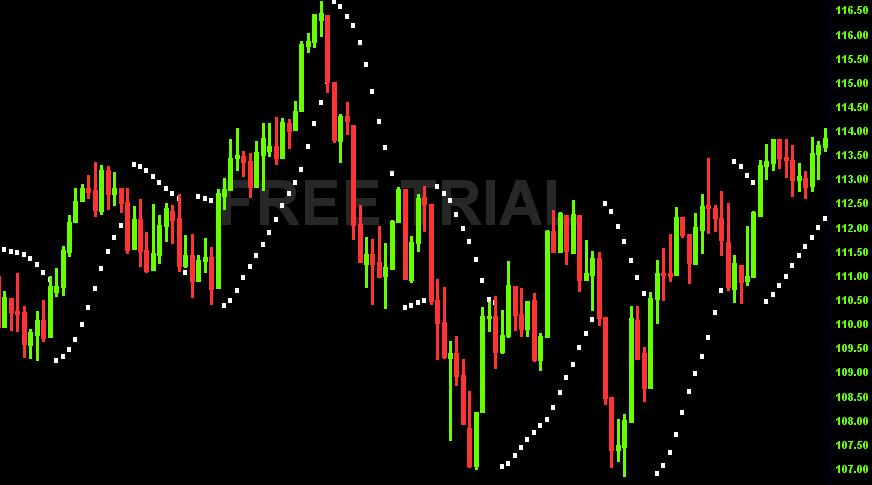PSAR was created by J. Welles Wilder and described in his „New concepts in technical trading systems“ book. PSAR means Parabolic Stop And Reverse. It is a trading tool that tells us when to change our positions - from BUY to SELL and vice versa. It is also used to identify the right moment to exit market - e.g. to set Stop Loss. The aim of PSAR indicator is to define the point at which we should Change or Exit our positions.
PSAR formula looks like follows:
SAR = [(EP) – (SAR n-1)] * AF + (SAR n-1)
EP = Extreme price for the trade. The extreme price is the Highest High for Long trades or Lowest Low for Short trades (HH or LL since we entered a trade).
AF = Acceleration factor. It rises from 0.02 to 0.2.
Acceleration factor defines the speed/distance at which PSAR approaches the Price graph. It begins on the level of 0,02 and rises 0.02 points every time the PSAR moves in the desired direction. The higher the PSAR value is, the closer it is to the price graph. The highest value it can reach is 0.2 - according to Wilder's methodology.

Copyright © Picture made by Incredible Charts
Using PSAR is quite simple. If the asset price moves bellow the PSAR level, we should Sell. If it moves above the PSAR level, we should BUY. It is similar to moving averages. The main difference is that PSAR, unlike moving average, gradually approaches the price graph. It gives less and less space for any price swings or trend reversals. In other words, if we enter a trade, PSAR gives the price enough space to move in the desired direction. At the beginning the market can be pretty choppy, but the longer we are in a trade, the less space for price swings and corrections there is so the lower our potential loss is.
PSAR moves a bit closer to price graph almost every day. It means that it works like a Stop Loss (if we want to exit market) or Stop and Reverse system (if we just want to change our positions - e.g. from Short to Long). As it moves closer and closer to the price graph, our loss is lower and lower every day, too.
PSAR is appropriate to use in a market that is pretty trending. In a case the market moves sideways and there is none trend prevailing, it gives us many false signals. That's the reason why J. Welles Wilder himself recommended to use PSAR in conjuction with any other trend indicator, in this case ADX (Average Directional Index). Other details can be found in his book: „New concepts in technical trading systems“.
Wilder formed these basic PSAR rules:
- We enter a trade when price crosses SAR. SAR becomes so the new extreme value for next calculations.
- Acceleration factor just increases when a new High is reached (for Long positions) and a new Low is reached (for Short trades). If the price can not overcome HH or LL, the acceleration factor remains the same.
- PSAR values shouldn't be in today's or yesterday's price range. It should allways be out of the range. If such situation occures, while we are in a Long trade, we use 2-day Lowest Low as the PSAR value for next day. The opposite is true for for Short trades.
There are some other rules for PSAR calculation. You can find them in the J. W. Wilder's book, for example. In present days the PSAR indicator is implemented into every analytic tool, so the only thing trader has to do, is to decide about the Acceleration factor settings.
In the end: Some traders are not happy about the large space the PSAR gives the price to move in at the beginning (when we enter a new trade). It means the Stop Loss is defined in a large distance from the price graph and traders must risk much more money. That's the reason why they tighten the Stop Loss at the beginning. They use PSAR as their new SL level just after it is close enough.
It is appropriate to use PSAR in conjuction with own settings of Money Management according to our own risk attitude.
If you are interested in a deeper study of this technical indicator and prefer ready to serve solutions, this section may be of interest to you. There you can find all the available indicators in Excel file for download.
